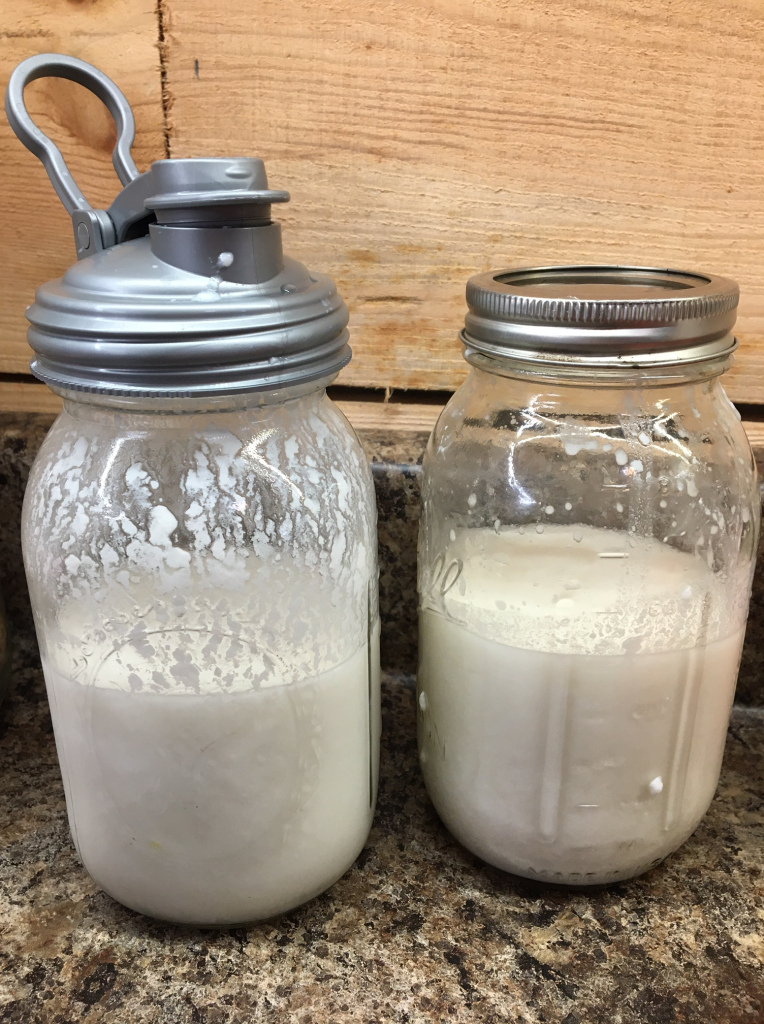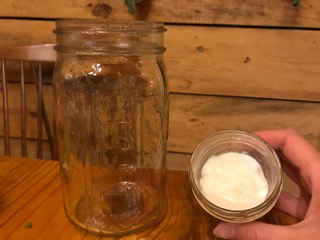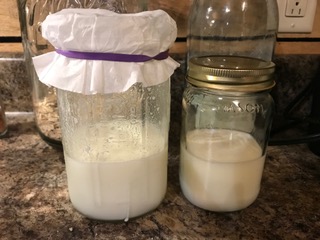A Fun Drink Called Kefir (What it is and How to make it!)

I have been making this stuff called kefir for nearly five years. It’s an ancient fermented milk drink that has been made for thousands of years and sustained nomadic people groups all over the globe! (Sounds appetizing, right?)
What is Kefir?
First, a few things about kefir. If you haven’t seen it in the grocery store yogurt section, you’re probably wondering what kind of crazy thing this is.
Kefir is basically a cultured milk drink. Think of it as drinkable yogurt. But unlike yogurt, you need to have grains—which look like a clumpy mass of cottage cheese—to begin culturing the milk.
To even get started making it, you’ll need to find a friend who has some extra grains, or purchase some online.
I’ve always been blessed with a kefir making friend. When I have lost my grains in the freezer, she came through for me. (Thanks again, Elizabeth!)
This article may contain affiliate links, which means if you choose to shop through my link, I may receive a small commission at no extra cost to you! Thank you!
What are the Health Benefits?
In Sally Fallon’s book, “Nourishing Traditions: The Cookbook that Challenges Politically Correct Nutrition and Diet Dictocrats“, she has a good chunk of info on why kefir is so great. I’ll just include a few sentences to give you the general idea.
“Kefir is a cultured and microbial-rich food that helps restore the inner ecology. …kefir does not feed yeast, and it usually doesn’t even bother people who are lactose intolerant… the friendly bacteria and the beneficial yeast growing in the kefir consume most of the lactose (of the milk) and provide very efficient enzymes (lactase) for consuming whatever lactose is still left after the culturing process…it creates a sort of nest where beneficial bacteria can settle and colonize (in the stomach)…”
“Research has shown that regular consumption of cultured dairy products lowers cholesterol and protects against bone loss…they keep pathogens at bay, guard against infectious illness and aid in the fullest possible digestion of all food we consume.”
So now that we know you definitely should have kefir culturing on your counter…here’s how to do it!
What Will I Need?
- Kefir grains (I got mine from a friend, or you can order from Cultures for Health.)
- Clean glass jars
- Plastic strainer with holes small enough so your grains won’t slip through
- (Optional) canning funnel to prevent spills. Mine is not pictured in my photos below.
- Wooden or plastic spoon
- Coffee filter, small tea towel, and rubber band to cover the kefir jar.
- Preferably raw whole milk. But any store bought milk, whole or skim, will be fine too!
The Kefir Making Process
1. First, as I already mentioned, you need to get ahold of some grains. I’ve heard that you can buy a kefir powder, but it’s not reusable like the grains are. (Check out Cultures For Health Milk Kefir Grains | Easy DIY Probiotic Kefir | Heirloom Kefir Grains Let You Re-use Them Many Times Without Any Loss In Nutrients | Non GMO, Gluten Free | 1 Packet In A Box for more info on purchasing a starter.)
2. Once you have the grains, the rest is pretty simple. Put the kefir grains in a clean quart jar. (All photos grouped below.)
3. Cover the grains with the milk. If this is your first round of kefir making after getting your grains, just make sure the grains are covered, because they will need to grow a little before you put a whole jar of milk on them. So here I just covered them and added enough milk to give them room to grow. I use a coffee filter and rubber band to cover my jar. (As always, cultured or fermented things don’t like metal, so just stick with glass or plastic.)
4. Let it sit out on your counter for 24 hours. My kefir making usually happens around 10 pm…so I just do it the same time every night before I go to bed.
5. After the 24 hours, you’ll have to strain your kefir. I use a plastic colander with little holes, so none of my grains slip through.
6. Use a wooden or plastic spoon to stir the grains around, ensuring all the liquid is going through.
7. Now…this part is hard for some people to handle…but I will do a second ferment, or double ferment. I leave the strained kefir out for another 24 hours! I promise, it won’t spoil! No refrigeration required yet.
8. So, we are left with a strainer full of clumpy kefir grains. Put them back into their original jar that you used the day before. (It doesn’t have to be cleaned but once every few weeks. It’s ok to keep it going in the same jar!)
9. Then add more milk on top, just like before. Except now that we’re on day two, add a little more milk to feed the grains. I think after a while, you will get the feel for how much milk you need to feed them. The more milk you give, the bigger the grains will grow, and you will have to divide them!
After this, just repeat these steps every day! It’s pretty simple and not time consuming once you get the hang of straining the grains.

Here are the grains. 
Always use plastic or wood. 
Do you see the grains now? 
Left: Strained into the cup. Right: jar waiting for the grains and fresh milk. 
Now the kefir is set out to culture once more. The jar with the lid will go through a second fermentation.
–The double fermented kefir will be ready the next day, too. It’s chocked full of probiotics. It’s ready to be used as a plain drink, or you can jazz it up with fruit, sweeteners, or whatever you feel like! I will place it in the fridge after the double ferment is up, so I can use it whenever I’m ready for it.–
Am I Going to Kill my Grains?
It’s pretty hard to kill kefir grains. If you just want a break for a week or two, they’ll be perfectly fine covered in milk, in the fridge. But if you want to take an extended break, just wash them with non-chlorinated water and store them in a jar with a little bit of water to cover them. Put in the freezer. To unthaw, just set them out, and proceed as if this were the first round. Add a little milk to prime them up, and then they will be good to go the next day!
I have found that once my grains grow and I’m adding almost a full quart of milk, that I will need a break because I’m overflowing with kefir faster than my family can drink it.

I’ll either give some grains away or freeze them. Like I said, they are pretty hardy little critters, and will survive a fair amount of neglect…I’ve had grains that were still alive that I left in the back of the fridge for several months! But maybe don’t do that just in case they die, and you’ll blame me ;).
Here’s a recipe for Chocolate Covered Strawberry Kefir for a great tasting, easy recipe to put your kefir to work.
Also try:
Also, try out unique Kefir Cheese. It’s easy, and fun to experiment with!
Holler at me if you have questions! Kefir is a fun kitchen adventure and I would love to see you get started.



The Truth About Goat’s Milk – J&R Farms
[…] I turn goats milk into kefir, there is a hint of “goat”. Think of what goat cheese smells like, it kind of tastes like tha….) But fresh milk has undetectable goat […]
Kiwi Banana Kefir Smoothie (THM-E) – J&R Farms
[…] Want to get started making your own kefir? Read all about it here: How to Make Kefir […]
Easy Greens Kefir Smoothie (THM-E, Low-fat) – J&R Farms
[…] I’ve summarized my kefir making process in this post if you’re interested: A Fun Drink Called Kefir (What it is and How to Make It.) […]